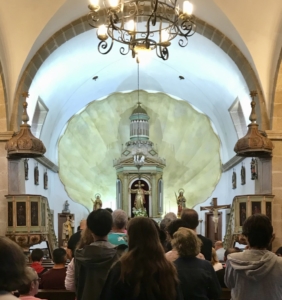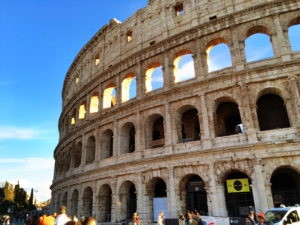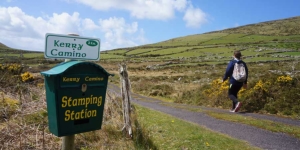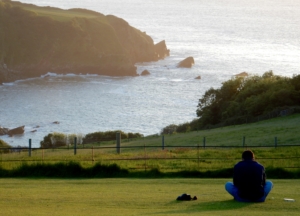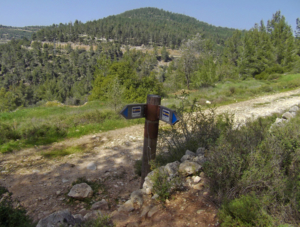Why Undertake a Pilgrimage?
There is an intriguing and mysterious trend afoot. In recent years, people with or without faith are rediscovering the benefits of pilgrimage. The Camino de Santiago alone has seen an increase in the number of pilgrims receiving their completion certificates from 1801 in 1986 to 327,378 in 2018. Many pilgrims take the journey for spiritual reasons: for retreat, self-growth or to connect more deeply with God. Others undertake it for the physical challenge or for cultural reasons. But regardless of the initial motivation, nearly all will acknowledge that something special happens on the journey.
Pilgrim trails can be found all over Europe and the world, but all have one thing in common: they are believed to be places where miracles once happened, still happen, and may happen again. One such miracle can simply be the revivification of faith.
There is something mysterious about pilgrimage that cuts across all faiths. Many report an increased sense of peace, connection or spiritual nourishment. Walking through nature eliminates the usual isolating hardware of modern life – gates, cars, concrete office buildings, earphones – and connects us with the wonders of the natural world. It’s beautifully slow. The rhythm of our own steps helps with reflection. For most of human history we were foot travelers. So pilgrimage is about connecting with our roots, and our planet, and creating a space to contemplate our lives.
Isn’t pilgrimage an antiquated, medieval Catholic practice?
Pilgrimage has been practiced by multiple faiths for millennia. The Greeks traveled to cities like Delphi to consult the divine through the oracle. The Jews made pilgrimages to Jerusalem to celebrate major feasts. In fact, pilgrimage was a spiritual discipline established by God in the Old Testament to help his people connect with him. Jesus’ parents went on pilgrimage to Jerusalem every year and we know that Jesus was with them at age 12 (Luke 2). Similarly, his first followers were in Jerusalem for Shavuot (The Feast of Weeks) – one of the three biblical pilgrimage festivals ordained by God – when the Holy Spirit was given to them. Pentecost’s first converts included sincere God-seekers on pilgrimage, including many Jewish pilgrims from as far away as Rome. And not long after, an Ethiopian eunuch on pilgrimage to Jerusalem had a divine encounter with Philip on a wilderness road.
The fact that God manifested himself to pilgrims should not be surprising. Throughout history God routinely appeared to people on journeys, especially in the wilderness. After Abraham left the comforts of Ur, God appeared to him multiple times as he roamed Canaan. Jacob received his vision of a heavenly ladder during an escape through the wilderness and years later, while spending the night alone on a riverside, wrestled with a divine visitor. Moses had been hiding in the Midian wilderness for 40 years when he encountered the burning bush. He then led the people of Israel through more wilderness where God repeatedly manifested Himself. Elijah escaped into the wilderness where God sent an angel to care for him and where he received his next assignment through a divine whisper. And Jesus himself was cared for by angels after 40 days of trials in the wilderness.
God often leads his people into a physical or metaphorical wilderness. It is there that we encounter his presence, perspective and provision; it is there that we find living water . . . and the wilderness becomes a place of transformation.
Due to medieval misunderstandings and abuses of pilgrimage, the original God-given intent was distorted. The Reformation further distanced Protestant Christians from the practice in its zeal to emphasize grace over works. But we want to recover the original intent and blessing pilgrimage can be as a life-giving spiritual discipline. It was God’s original idea for us.
Potential Outcomes
How Can a Pilgrimage Help Me?
Renew your spiritual life
 Life can run us ragged. Good things like our career, family and church obligations may be slowly squeezing God, our prime sustainer, out of our lives. Slowly the fruit of abundant life we once yielded sours on the vine as it turns to impatience, anger or worse. In such times our souls need to retreat into a quiet environment to seek God’s perspective on life. A pilgrimage can help you connect with God more purposefully and renew your spirit.
Life can run us ragged. Good things like our career, family and church obligations may be slowly squeezing God, our prime sustainer, out of our lives. Slowly the fruit of abundant life we once yielded sours on the vine as it turns to impatience, anger or worse. In such times our souls need to retreat into a quiet environment to seek God’s perspective on life. A pilgrimage can help you connect with God more purposefully and renew your spirit.
Discern a new direction
 Life transitions–the end of a career or marriage, the death of a loved one, a health crisis, an empty nest–tax the soul tremendously. Pilgrimage is a time-tested practice that helps people transition from one season to the next. The quiet hours spent alone in nature, or in deep conversation with fellow pilgrims, nourishes the discernment process. It provides much-needed time and space to midwife a refined life purpose–that intersection between your passion and skills and the needs of the world.
Life transitions–the end of a career or marriage, the death of a loved one, a health crisis, an empty nest–tax the soul tremendously. Pilgrimage is a time-tested practice that helps people transition from one season to the next. The quiet hours spent alone in nature, or in deep conversation with fellow pilgrims, nourishes the discernment process. It provides much-needed time and space to midwife a refined life purpose–that intersection between your passion and skills and the needs of the world.
Increase your self-awareness
 Socrates once said, “the unexamined life is not worth living.” On a routine basis we need to break the numbing rhythms of daily life to gain perspective and clarity. This will increase your self-awareness and make you a better spouse, employee or parent. A pilgrimage will provide you with a sacred space for reflection, prayer and meditation so that you can return to daily life with new insights, goals and energy.
Socrates once said, “the unexamined life is not worth living.” On a routine basis we need to break the numbing rhythms of daily life to gain perspective and clarity. This will increase your self-awareness and make you a better spouse, employee or parent. A pilgrimage will provide you with a sacred space for reflection, prayer and meditation so that you can return to daily life with new insights, goals and energy.
Surmount a physical challenge
 Journeys into nature–into the wilderness–invariably come with challenges. Discomfort. Foreign tastes. Uncooperative weather. Tired muscles. Growth happens when we intentionally pull ourselves out of the comforts of daily life and stretch ourselves. Physical challenges help us grow spiritually and emotionally because we dig deep. We deepen our reliance on God. We discover that we can overcome more than we think. And we get fit in the process!
Journeys into nature–into the wilderness–invariably come with challenges. Discomfort. Foreign tastes. Uncooperative weather. Tired muscles. Growth happens when we intentionally pull ourselves out of the comforts of daily life and stretch ourselves. Physical challenges help us grow spiritually and emotionally because we dig deep. We deepen our reliance on God. We discover that we can overcome more than we think. And we get fit in the process!
Draw wisdom from community
 The kind of person attracted to pilgrimage is like you – longing for authentic, meaningful connection with the world. The pilgrimage paradox is that even though you may have hours alone on the trail, you are never really alone. Pilgrims look out for each other. At wayside cafes or over evening meals, you will have powerful, authentic conversations. It may be a stray phrase, or an entertaining story, but others will unknowingly speak wisdom into your life, just as you will speak into theirs. If you prefer to keep to yourself most of the time, your choice will always be respected. But though you begin the journey as a stranger, you will still very likely end as a friend. You will find yourself mysteriously attracted to the wisdom of likeminded pilgrims from many corners of the globe.
The kind of person attracted to pilgrimage is like you – longing for authentic, meaningful connection with the world. The pilgrimage paradox is that even though you may have hours alone on the trail, you are never really alone. Pilgrims look out for each other. At wayside cafes or over evening meals, you will have powerful, authentic conversations. It may be a stray phrase, or an entertaining story, but others will unknowingly speak wisdom into your life, just as you will speak into theirs. If you prefer to keep to yourself most of the time, your choice will always be respected. But though you begin the journey as a stranger, you will still very likely end as a friend. You will find yourself mysteriously attracted to the wisdom of likeminded pilgrims from many corners of the globe.
Delight in culture and history
 Our pilgrimage routes are chosen for their rich cultural legacy. All of them have been traveled for at least 1000 years. Lovers of history will not be disappointed as they pass stone buildings whispering tales of passion, sacrifice, war and love. But these paths are still making history as gracious locals craft delectable cheeses and delightful wines over which they regale visitors with stories about daily life in their villages.
Our pilgrimage routes are chosen for their rich cultural legacy. All of them have been traveled for at least 1000 years. Lovers of history will not be disappointed as they pass stone buildings whispering tales of passion, sacrifice, war and love. But these paths are still making history as gracious locals craft delectable cheeses and delightful wines over which they regale visitors with stories about daily life in their villages.
Reenergize in nature
 Many of us live in urban environments surrounded by mankind’s decaying monuments. The natural world is pushed to the periphery. This is not only bad for the soul, it is bad for our health. Science tells us that this is because the air in today’s modern world is overstuffed with positive ions. They are absorbed into our bodies from lighting, computers, mobile phones, Wi-Fi devices and air conditioning systems. Excessive levels of positive ions can upset our bodies’ electrical balance resulting in poor concentration, stress, tiredness, irritation and depression.
Many of us live in urban environments surrounded by mankind’s decaying monuments. The natural world is pushed to the periphery. This is not only bad for the soul, it is bad for our health. Science tells us that this is because the air in today’s modern world is overstuffed with positive ions. They are absorbed into our bodies from lighting, computers, mobile phones, Wi-Fi devices and air conditioning systems. Excessive levels of positive ions can upset our bodies’ electrical balance resulting in poor concentration, stress, tiredness, irritation and depression.
In contrast, nature has an abundance of negative ions to counteract these effects. Negative ions can be found in abundance around certain natural features such as mountains, waterfalls and beaches. Once they reach our bloodstream, negative ions are believed to increase levels of serotonin, helping to alleviate depression, relieve stress, and boost our energy. Generally speaking, negative ions also increase the flow of oxygen to the brain, resulting in higher alertness, decreased drowsiness, and more mental energy.
When we connect with the supernatural wonder of nature we refresh our spirits as well as our bodies.
Explore the Ancient Ways

